Tarek Ahmed. Reservoir engineering handbook
Подождите немного. Документ загружается.


The use of these models in connection with Equation 11-44 to simulta-
neously determine N and W
e
is described below.
The Pot-Aquifer Model in the MBE
Assume that the water influx could be properly described using the
simple pot aquifer model given by Equation 10-5 as:
W
e
= (c
w
+ c
f
) W
i
f (p
i
− p) (11 - 45)
where r
a
= radius of the aquifer, ft
r
e
= radius of the reservoir, ft
h = thickness of the aquifer, ft
φ=porosity of the aquifer
θ=encroachment angle
c
w
= aquifer water compressibility, psi
−1
c
f
= aquifer rock compressibility, psi
−1
W
i
= initial volume of water in the aquifer, bbl
Since the aquifer properties c
w
, c
f
, h, r
a
, and θ are seldom available, it
is convenient to combine these properties and treated as one unknown K.
Equation 11-45 can be rewritten as:
W
e
= K ∆p (11- 46)
Combining Equation 11-46 with Equation 11-44 gives:
Equation 11-47 indicates that a plot of the term (F/E
o
) as a function of
(∆p/E
o
) would yield a straight line with an intercept of N and slope of K,
as illustrated in Figure 11-23.
F
E
NK
p
E
oo
=+
∆
(11- 47)
f
encroachment angle
W
rrh
o
oo
i
ae
==
=
−
()
()
.
360 360
5 615
22
θ
πφ
768 Reservoir Engineering Handbook
Reservoir Eng Hndbk Ch 11 2001-10-25 15:59 Page 768
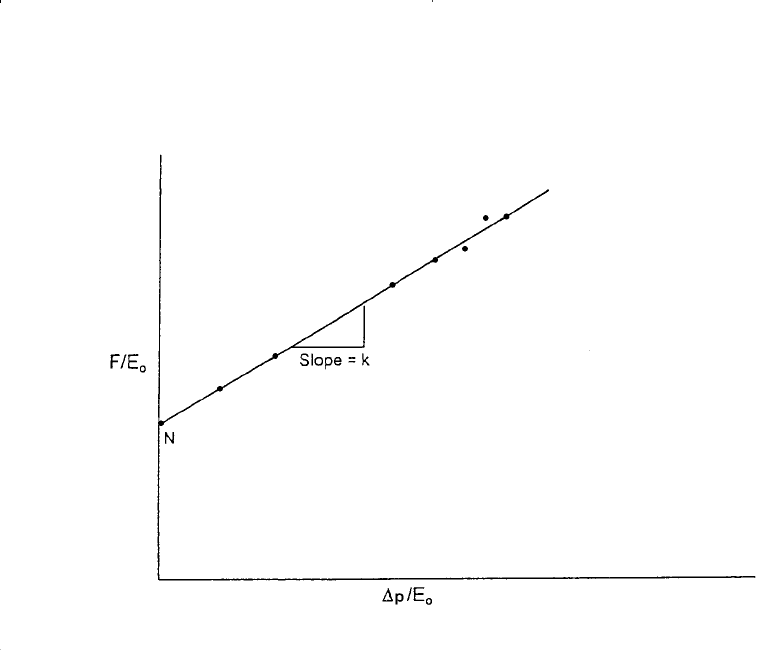
The Steady-State Model in the MBE
The steady-state aquifer model as proposed by Schilthuis (1936) is
given by:
where W
e
= cumulative water influx, bbl
C = water influx constant, bbl/day/psi
t = time, days
p
i
= initial reservoir pressure, psi
p = pressure at the oil-water contact at time t, psi
WCppdt
ei
o
t
=−
∫
( ) (11- 48)
Oil Recovery Mechanisms and the Material Balance Equation 769
Figure 11-23. F/E
o
vs. ∆p/E
o
.
Reservoir Eng Hndbk Ch 11 2001-10-25 15:59 Page 769

Combining Equation 11-48 with Equation 11-44 gives:
Plotting (F/E
o
) versus results in a straight line with an
intercept that represents the initial oil in place N and a slope that
describes the water influx C as shown in Figure 11-24.
The Unsteady-State Model in the MBE
The van Everdingen-Hurst unsteady-state model is given by:
W
e
= B Σ ∆p W
eD
(11-50)
with
B = 1.119 φ c
t
r
e
2
h f
Van Everdingen and Hurst presented the dimensionless water influx
W
eD
as a function of the dimensionless time t
D
and dimensionless radius
r
D
that are given by:
where t = time, days
k = permeability of the aquifer, md
φ=porosity of the aquifer
µ
w
= viscosity of water in the aquifer, cp
t
kt
cr
r
r
r
cc c
D
wte
D
a
e
twf
=×
=
=+
−
6 328 10
3
2
.
φµ
()/p p dt E
io
o
t
−
∫
F
E
NC
ppdt
E
o
i
o
t
o
=+
−
∫
()
(11- 49)
770 Reservoir Engineering Handbook
Reservoir Eng Hndbk Ch 11 2001-10-25 15:59 Page 770
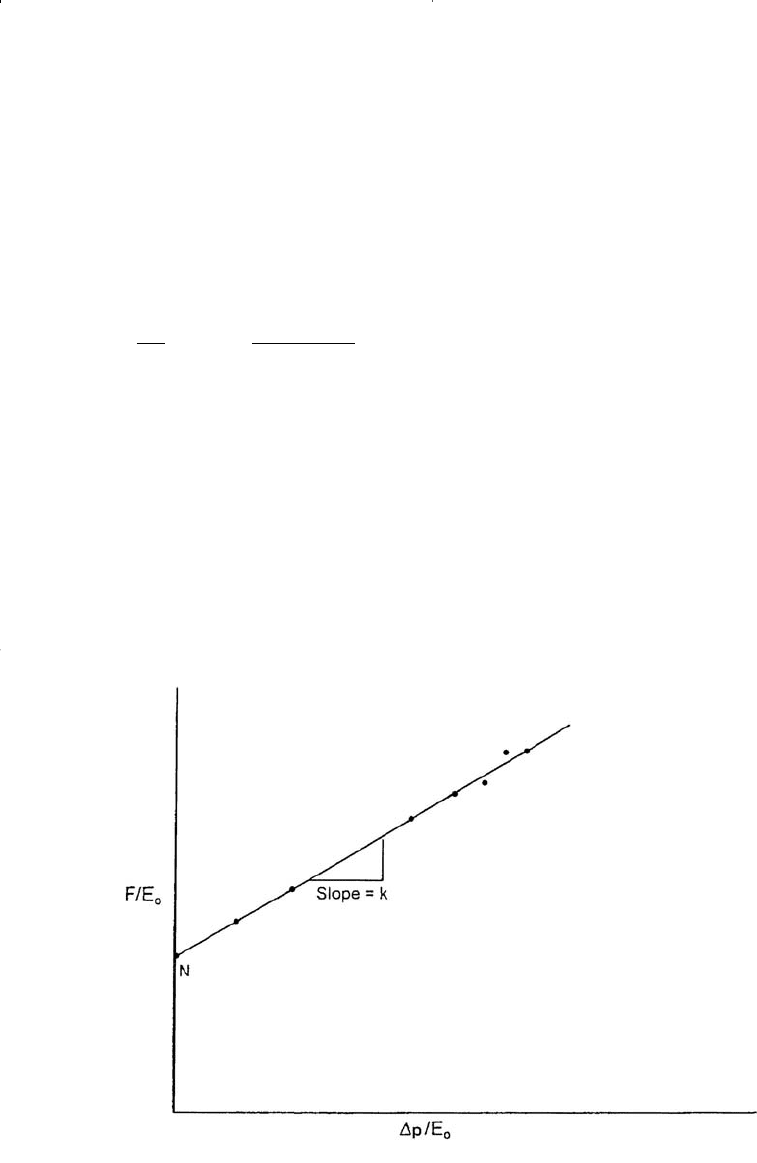
r
a
= radius of the aquifer, ft
r
e
= radius of the reservoir, ft
c
w
= compressibility of the water, psi
−1
Combining Equation 11-50 with Equation 11-44 gives:
The proper methodology of solving the above linear relationship is
summarized in the following steps.
Step 1. From the field past production and pressure history, calculate the
underground withdrawal F and oil expansion E
o
.
Step 2. Assume an aquifer configuration, i.e., linear or radial.
Step 3. Assume the aquifer radius r
a
and calculate the dimensionless
radius r
D
.
F
E
NB
pW
E
o
eD
o
=+
∑
∆
(11- 51)
Oil Recovery Mechanisms and the Material Balance Equation 771
Figure 11-24. Graphical determination of N and c.
Reservoir Eng Hndbk Ch 11 2001-10-25 15:59 Page 771

Step 4. Plot (F/E
o
) versus (Σ ∆p W
eD
)/E
o
on a Cartesian scale. If the
assumed aquifer parameters are correct, the plot will be a straight
line with N being the intercept and the water influx constant B
being the slope. It should be noted that four other different plots
might result. These are:
• Complete random scatter of the individual points, which indi-
cates that the calculation and/or the basic data are in error.
• A systematically upward curved line, which suggests that the
assumed aquifer radius (or dimensionless radius) is too small.
• A systematically downward curved line, indicating that the
selected aquifer radius (or dimensionless radius) is too large.
• An s-shaped curve indicates that a better fit could be obtained if
a linear water influx is assumed.
Figure 11-25 shows a schematic illustration of Havlena-Odeh (1963)
methodology in determining the aquifer fitting parameters.
Example 11-5
The material balance parameters, the underground withdrawal F, and
oil expansion E
o
of a saturated-oil reservoir (i.e., m = o) are given below:
pF E
o
3500 — —
3488 2.04 × 10
6
0.0548
3162 8.77 × 10
6
0.1540
2782 17.05 × 10
6
0.2820
Assuming that the rock and water compressibilities are negligible, cal-
culate the initial oil in place.
Solution
Step 1. The most important step in applying the MBE is to verify that no
water influx exists. Assuming that the reservoir is volumetric, cal-
culate the initial oil in place N by using every individual produc-
tion data point in Equation 11-38, or:
N = F/E
o
772 Reservoir Engineering Handbook
Reservoir Eng Hndbk Ch 11 2001-10-25 15:59 Page 772
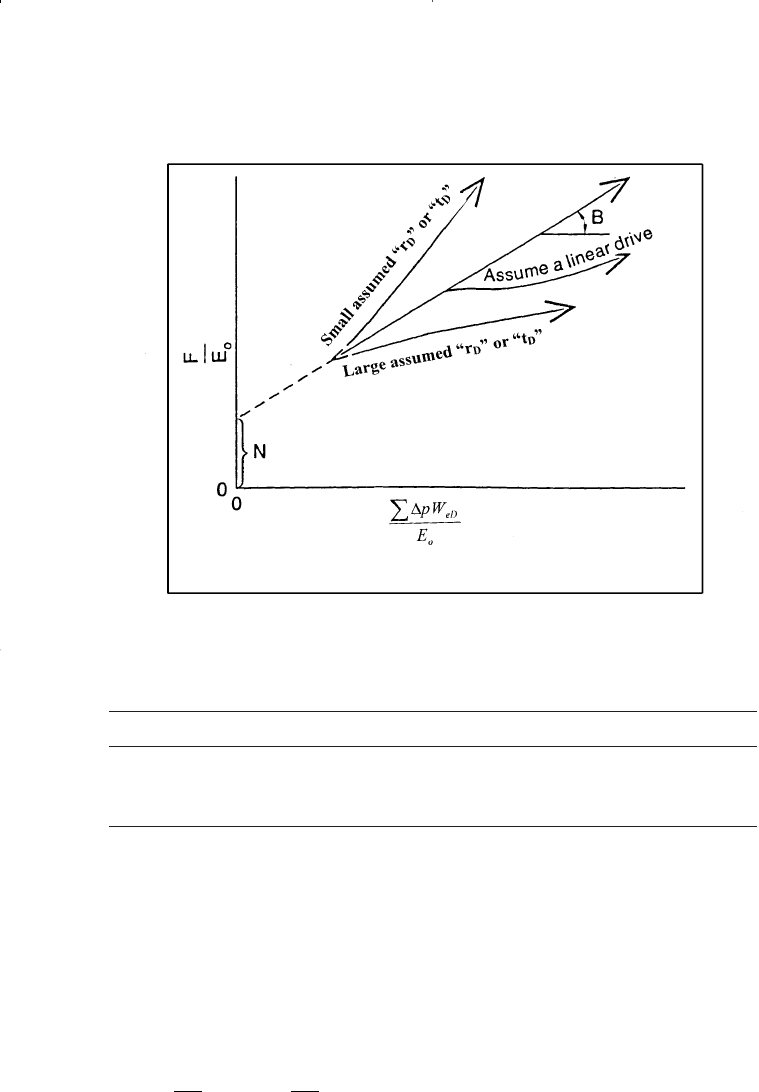
FE
o
N = F/E
o
2.04 × 10
6
0.0548 37 MMSTB
8.77 × 10
6
0.1540 57 MMSTB
17.05 × 10
6
0.2820 60 MMSTB
Step 2. The above calculations show the calculated values of the initial
oil in place are increasing (as shown graphically in Figure 11-26),
which indicates a water encroachment, i.e., water-drive reservoir.
Step 3. For simplicity, select the pot-aquifer model to represent the
water encroachment calculations in the MBE as given by Equa-
tion 11-47, or:
F
E
NK
p
E
oo
=+
∆
Oil Recovery Mechanisms and the Material Balance Equation 773
Figure 11-25. Havlena and Odeh straight-line plot. (Source: Havlena and
Odeh, 1963.)
Reservoir Eng Hndbk Ch 11 2001-10-25 15:59 Page 773
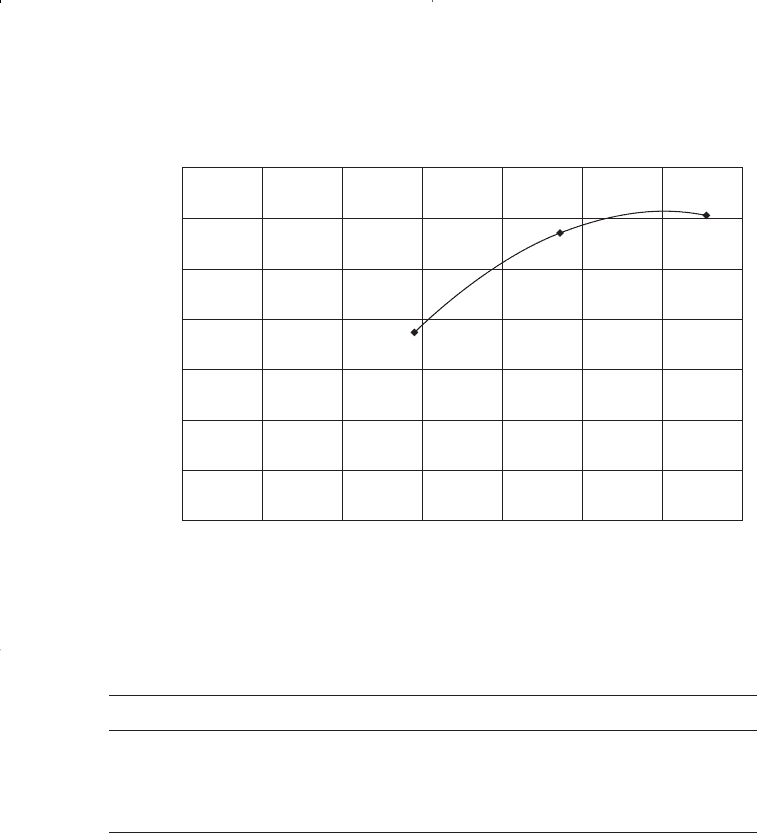
Step 4. Calculate the terms (F/E
o
) and (∆p/E
o
) of Equation 11-47.
p ∆pF E
o
F/E
o
∆p/E
o
3500 0 — — — —
3488 12 2.04 × 10
6
0.0548 37.23 × 10
6
219.0
3162 338 8.77 × 10
6
0.1540 56.95 × 10
6
2194.8
2782 718 17.05 × 10
6
0.2820 60.46 × 10
6
2546
Step 5. Plot (F/E
o
) versus (∆p/E
o
), as shown in Figure 11-27, and deter-
mine the intercept and the slope.
Intercept = N = 35 MMSTB
Slope = K = 9983
Tracy’s Form of the Material Balance Equation
Neglecting the formation and water compressibilities, the general
material balance equation as expressed by Equation 11-13 can be reduced
to the following:
774 Reservoir Engineering Handbook
0.00E+07
0
Time, days
N, STB
200 400 600 800 1000 1200 1400
1.00E+07
2.00E+07
3.00E+07
4.00E+07
5.00E+07
6.00E+07
7.00E+07
Figure 11-26. Indication of water influx.
Reservoir Eng Hndbk Ch 11 2001-10-25 15:59 Page 774
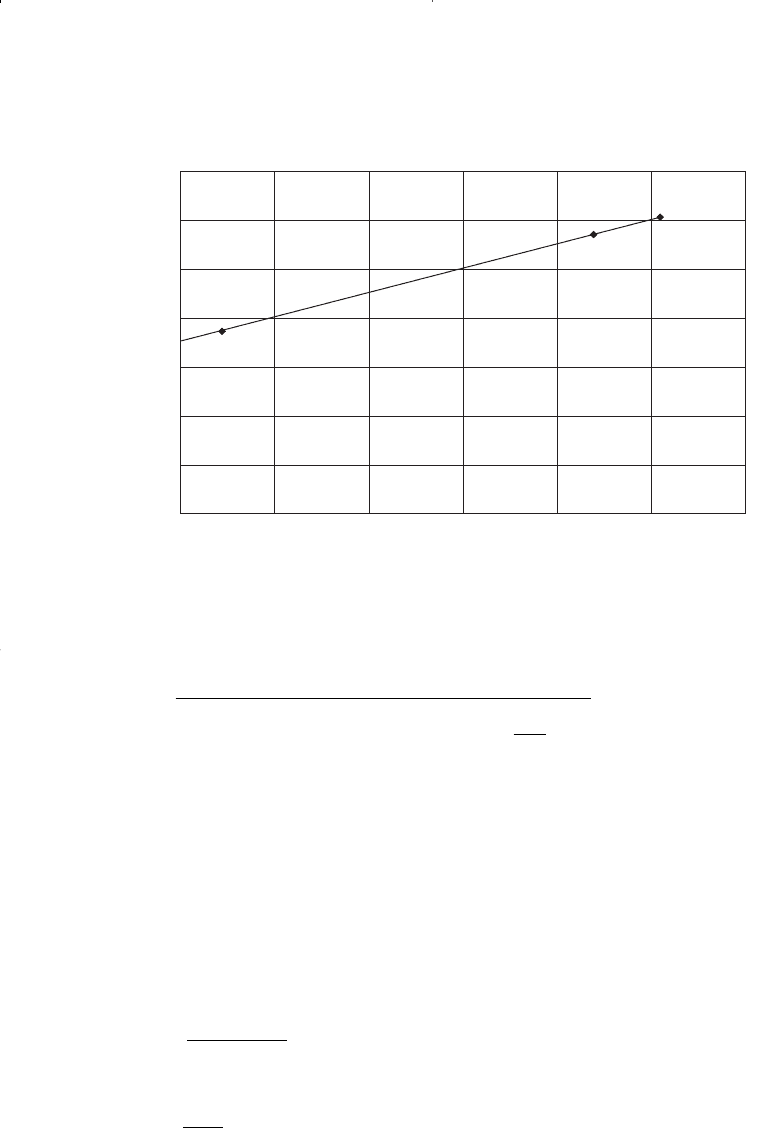
Tracy (1955) suggested that the above relationship can be rearranged
into a more usable form as:
N = N
p
Φ
o
+ G
p
Φ
g
+ (W
p
B
w
− W
e
) Φ
w
(11-53)
where Φ
o
, Φ
g
, and Φ
w
are considered PVT related properties that are
functions of pressure and defined by:
Φ
g
g
B
Den
(11- 55)=
Φ
o
osg
BRB
Den
=
−
(11- 54)
N
NB G N R B W WB
BB R RBmB
B
B
po p p s g e pw
ooi sisg oi
g
gi
=
+− − −
−+− + −
()( )
()() 1
(11- 52)
Oil Recovery Mechanisms and the Material Balance Equation 775
0.00E+07
0
∆p/E
o
F/E
o
500 1000 1500 2000 2500 3000
1.00E+07
2.00E+07
3.00E+07
4.00E+07
5.00E+07
6.00E+07
7.00E+07
N=35 MMSTB
Figure 11-27. F/E
o
versus ∆p/E
o
.
Reservoir Eng Hndbk Ch 11 2001-10-25 15:59 Page 775

with
where Φ
o
= oil PVT function
Φ
g
= gas PVT function
Φ
w
= water PVT function
Figure 11-28 gives a graphical presentation of the behavior of Tracy’s
PVT functions with changing pressure.
Notice that Φ
o
is negative at low pressures and all Φ functions are
approaching infinity at bubble-point pressure. Tracy’s form is valid only
for initial pressures equal to bubble-point pressure and cannot be used at
pressures above bubble point. Furthermore, the shape of the Φ function
curves illustrate that small errors in pressure and/or production can cause
large errors in calculated oil in place at pressures near the bubble point.
Steffensen (1992), however, pointed out the Tracy’s equation uses the
oil formation volume factor at the bubble-point pressure B
ob
for the ini-
tial B
oi
which causes all the PVT functions to become infinity at the bub-
ble-point pressure. Steffensen suggested that Tracy’s equation could be
extended for applications above the bubble-point pressure, i.e., for under-
saturated-oil reservoirs, by simply using the value of B
o
at the initial
reservoir pressure. He concluded that Tracy’s methodology could predict
reservoir performance for the entire pressure range from any initial pres-
sure down to abandonment.
The following example is given by Tracy (1955) to illustrate his pro-
posed approach.
Example 11-6
The production history of a saturated-oil reservoir is as follows:
Pressure, psia Cumulative Oil, MSTB Cumulative Gas, MMscf
1690 0 0
1600 398 38.6
1500 1570 155.8
1100 4470 803
Den B B R R B m B
B
B
ooi sisg oi
g
gi
=− +− + −
( ) ( ) 1 (11- 57)
φ
w
Den
=
1
(11- 56)
776 Reservoir Engineering Handbook
Reservoir Eng Hndbk Ch 11 2001-10-25 15:59 Page 776

The calculated values of the PVT functions are given below:
Pressure, psia Φ
o
Φ
g
1600 36.60 0.4000
1500 14.30 0.1790
1100 2.10 0.0508
Calculate the oil in place N.
Oil Recovery Mechanisms and the Material Balance Equation 777
Figure 11-28. Tracy’s PVT functions.
Reservoir Eng Hndbk Ch 11 2001-10-25 15:59 Page 777
